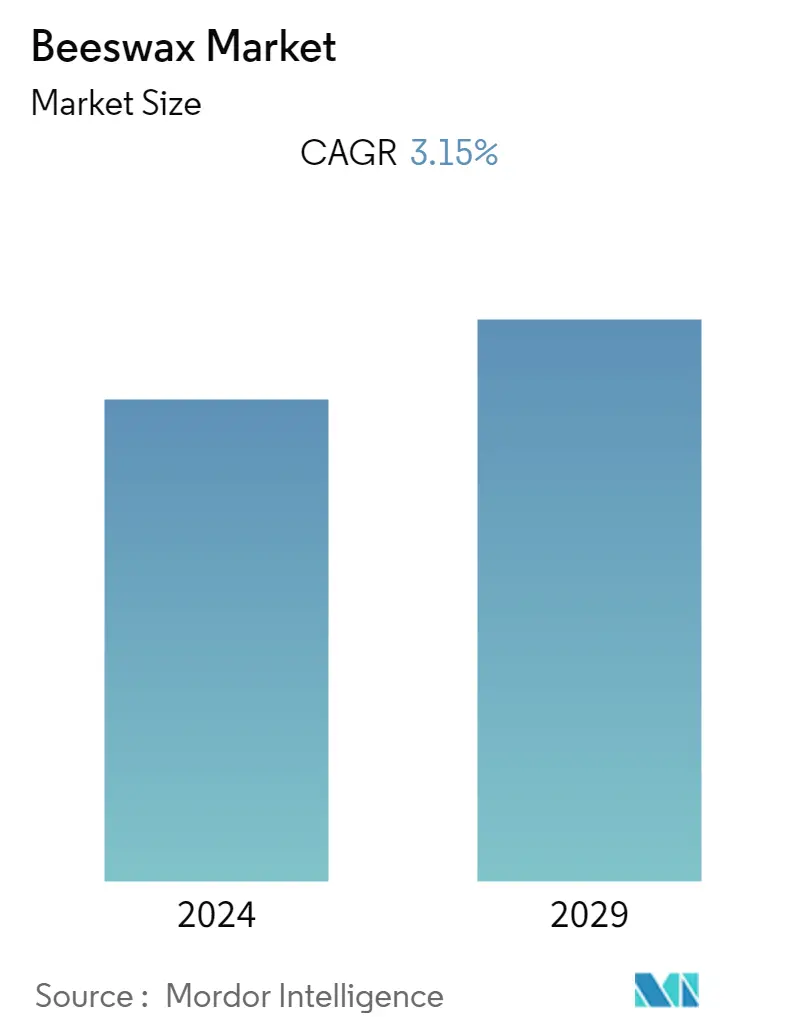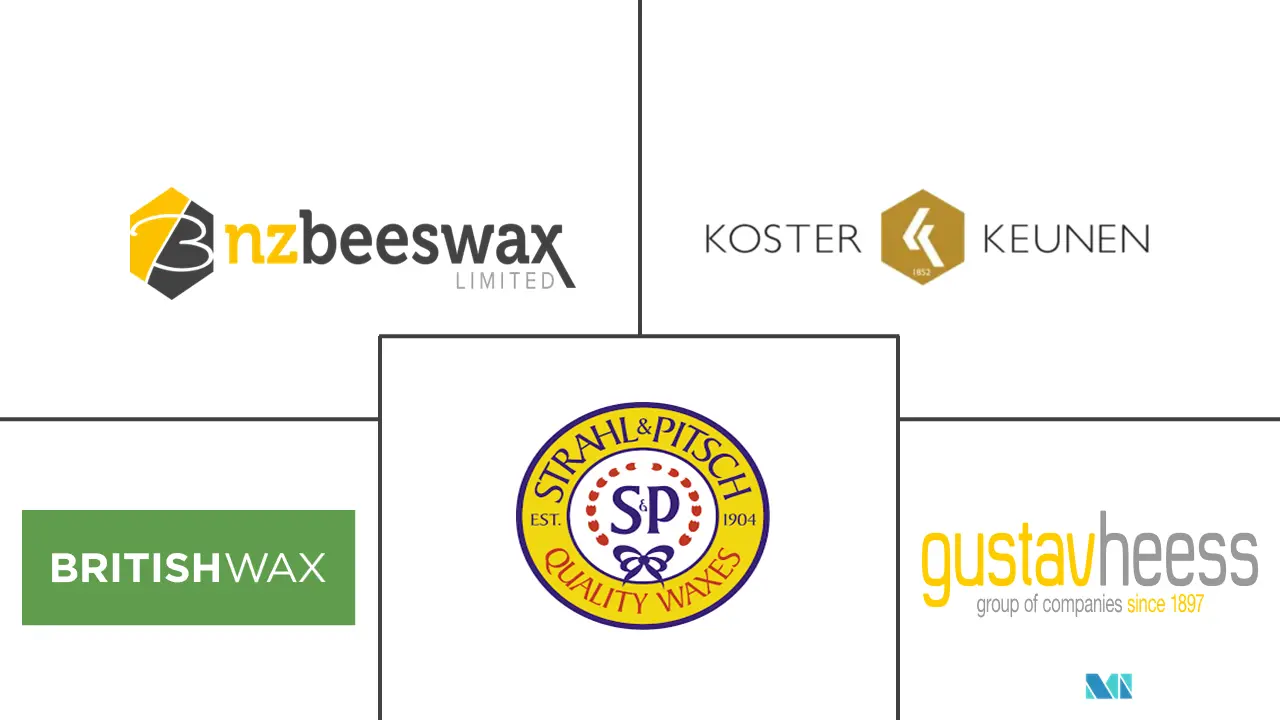Market Size of Beeswax Industry

| Study Period | 2019 - 2029 |
| Base Year For Estimation | 2023 |
| CAGR | 3.15 % |
| Fastest Growing Market | North America |
| Largest Market | Asia-Pacific |
| Market Concentration | Low |
Major Players
*Disclaimer: Major Players sorted in no particular order |
Beeswax Market Analysis
The beeswax market size is expected to grow from USD 530.51 million in 2023 to USD 619.50 million by 2028, registering a CAGR of 3.15% during the forecast period.
- A wide range of applications of beeswax in different end-use industries is the key factor that drives market growth. Due to the various therapeutical benefits associated with beeswax, it is used to treat several dermatological conditions, including boils, wounds, atopic dermatitis, psoriasis, and pediatric dermatitis. It also aids in lowering cholesterol, relieving pain, and treating inflammation, ulcers, diarrhea, and hiccups.
- Beeswax has a multitude of skincare benefits. It forms a protective barrier on the skin's surface from environmental irritants and harsh weather. Its anti-allergenic, anti-inflammatory, antioxidant, anti-bacterial, and germicidal properties make it a highly stable base ingredient in extending the shelf life of cosmetic products. Yellow and white beeswax are used as thickeners, emulsifiers, and stiffening agents in cosmetic manufacturing. Beeswax is used as a fragrance in soaps and perfumes.
- Beeswax contains various natural compounds, including fatty-acid esters, hydrocarbons, diesters, triesters, and acid polyesters. The edible coating of beeswax, coconut oil, and sunflower oil on fruits like strawberries and apricots retains moisture and maintains appearance, texture, and firmness. Thus, due to its antimicrobial properties against several bacteria and fungi, beeswax is used as a wax cover for fermented foods and cheeses. Moreover, in the food and beverage industry, yellow beeswax treated with alcohol is used as a stiffening agent.
- Besides this, government initiatives provide lucrative opportunities for key players to expand their consumer base, boosting market growth. For instance, in 2022, the Government of India launched Sweet Revolution, which aims to promote apiculture, known as beekeeping, and accelerate the production of quality honey and other related products. To provide a booster shot to Sweet Revolution, the government also launched the National Beekeeping and Honey Mission to promote and develop scientific beekeeping in mission mode.
Beeswax Industry Segmentation
Naturally generated and secreted by honeybees, beeswax is a substance derived directly from the honeycomb and exudes the aroma of honey. Due to its properties and composition, beeswax is widely used in aromatherapy, cosmetics, pharmaceuticals, and food manufacturing.
The report on beeswax provides a segmental market analysis according to product type, application, and geography. The market is segmented into pharmaceuticals, cosmetics, and other applications based on application. By product type, the market is segmented into organic and conventional. By geography, the study analyzes the market into emerging and established markets across the globe, including North America, Europe, Asia-Pacific, South America, and Middle East & Africa.
The market sizing has been done in value terms in USD for all the above-mentioned segments.
| Application | |
| Cosmetics | |
| Pharmaceuticals | |
| Other Applications |
| Product Type | |
| Organic | |
| Conventional |
| Geography | ||||||||
| ||||||||
| ||||||||
| ||||||||
| ||||||||
|
Beeswax Market Size Summary
The beeswax market is poised for steady growth, driven by its diverse applications across various end-use industries. Its therapeutic benefits make it a popular choice in the pharmaceutical sector for treating dermatological conditions and alleviating symptoms like inflammation and pain. In the cosmetics industry, beeswax is valued for its ability to act as a protective barrier and its stability as a base ingredient, extending the shelf life of products. Additionally, its antimicrobial properties make it a preferred ingredient in the food and beverage industry, where it is used as a natural preservative and additive. Government initiatives, such as India's Sweet Revolution, further bolster market expansion by promoting apiculture and the production of beeswax-related products.
Consumer demand for natural and organic products is significantly influencing the beeswax market, as individuals increasingly seek eco-friendly and sustainable alternatives to synthetic ingredients. This trend is particularly evident in the cosmetics sector, where there is a growing preference for clean beauty products. The Asia-Pacific region, with its rising income levels and shift towards organic ingredients, is a key driver of market growth, especially in countries like China and Japan. The competitive landscape of the global beeswax market is marked by the presence of several regional and international players, who are expanding their product offerings and enhancing their brand presence through strategic initiatives.
Beeswax Market Size - Table of Contents
-
1. MARKET DYNAMICS
-
1.1 Market Drivers
-
1.1.1 Beeswax: a Multifunctional Excipient
-
-
1.2 Market Restraints
-
1.2.1 Allergic Reaction Limits the Demand for Beeswax-Based Products
-
-
1.3 Porter's Five Forces Analysis
-
1.3.1 Threat of New Entrants
-
1.3.2 Bargaining Power of Buyers
-
1.3.3 Bargaining Power of Suppliers
-
1.3.4 Threat of Substitute Products
-
1.3.5 Intensity of Competitive Rivalry
-
-
-
2. MARKET SEGMENTATION
-
2.1 Application
-
2.1.1 Cosmetics
-
2.1.2 Pharmaceuticals
-
2.1.3 Other Applications
-
-
2.2 Product Type
-
2.2.1 Organic
-
2.2.2 Conventional
-
-
2.3 Geography
-
2.3.1 North America
-
2.3.1.1 United States
-
2.3.1.2 Canada
-
2.3.1.3 Mexico
-
2.3.1.4 Rest of North America
-
-
2.3.2 Europe
-
2.3.2.1 Germany
-
2.3.2.2 United Kingdom
-
2.3.2.3 France
-
2.3.2.4 Russia
-
2.3.2.5 Spain
-
2.3.2.6 Rest of Europe
-
-
2.3.3 Asia-Pacific
-
2.3.3.1 India
-
2.3.3.2 China
-
2.3.3.3 Japan
-
2.3.3.4 Rest of Asia-Pacific
-
-
2.3.4 South America
-
2.3.4.1 Brazil
-
2.3.4.2 Argentina
-
2.3.4.3 Rest od South America
-
-
2.3.5 Middle East and Africa
-
2.3.5.1 United Arab Emirates
-
2.3.5.2 South Africa
-
2.3.5.3 Rest of Middle East and Africa
-
-
-
Beeswax Market Size FAQs
What is the current Beeswax Market size?
The Beeswax Market is projected to register a CAGR of 3.15% during the forecast period (2024-2029)
Who are the key players in Beeswax Market?
Koster Keunen LLC, Gustav Heess Oleochemische Erzeugnisse GmbH, British Wax Refining Company Limited, Strahl and Pitsch and New Zealand Beeswax Ltd are the major companies operating in the Beeswax Market.

